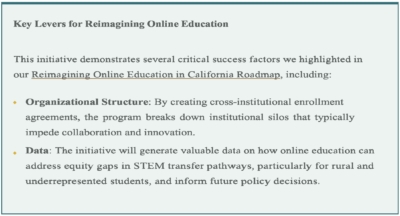The Central Valley Higher Education Consortium and member UC Merced have joined forces with the University of California Office of the President and the California Community College Chancellor’s Office to launch a pilot program expanding community college students’ access to advanced mathematics courses through cross-campus online education: Campaign for Transfer Excellence (CTE), a UC systemwide initiative designed to improve transfer pathways—particularly for stem majors—from California Community Colleges (CCCs) to UC campuses. This article from California Competes’ “Promising Practices in Online Education” series — highlighting ways California institutions and faculty harness online education for student success — chronicles how this collaborative effort with Central Valley community colleges tackles transfer barriers by pooling institutional resources and using technology to overcome geographic and institutional constraints.
How UC Merced Uses Online Education to Strengthen Rural STEM Transfer Pathways
COMMENTARY / JULY 29, 2025
By Laura Bernhard, PhD
Senior Researcher, California Competes
This bright spot is part of our “Promising Practices in Online Education” series highlighting ways California institutions and faculty harness online education for student success.
California Competes continues to research and document these innovations in support of a more agile higher education system responsive to the needs of today’s students and economy.
The Challenge: Meeting Advanced Math Course Demand in California’s Rural Communities
Community college students in California’s Central Valley face unique challenges on their path to four-year institutions, including limited access to the required course needed to transfer. The challenge is particularly acute in advanced mathematics courses like Linear Algebra & Differential Equations—a key stepping stone for students pursuing degrees in science, technology, engineering, and mathematics (STEM). Among the Central Valley’s 15 community colleges, fewer than 5 offer the advanced math course regularly. This scarcity comes from the fact that courses typically require minimum enrollment thresholds to run, but rural colleges struggle to meet these numbers consistently.
When students can’t enroll in required courses, they are more likely to stop out the next term.1 And once they have an initial stop out, they are more likely to have subsequent stop outs and less likely to graduate.2 With advanced math course availability limited at many rural colleges, talented students in these communities face barriers to staying on track. And because nearly half of all STEM jobs require a bachelor’s degree or higher, these access gaps have consequences for both economic mobility and regional growth.3 The result is a cycle where students from rural communities face limited opportunities to secure high-paying STEM careers, while rural regions remain underrepresented in high-growth industries and miss out on the economic growth and innovation that comes with a skilled STEM workforce.
With Central Valley community colleges transferring fewer students to the University of California (UC) than other community colleges across the state, a UC- led initiative focused on improving transfer outcomes in the region.4 The University of California Office of the President (UCOP) sought to address these transfer inequities by strengthening pathways between local community colleges and UC Merced—the region’s sole UC campus.
 “Education is a social justice issue. In 2025, the technological and structural elements are in place to address the longstanding obstacle of talent being widely distributed across California but opportunity lacking that same distribution.” – Rolin Moe, Executive Director of UC Online and one of the facilitators of this cross-institutional partnership
“Education is a social justice issue. In 2025, the technological and structural elements are in place to address the longstanding obstacle of talent being widely distributed across California but opportunity lacking that same distribution.” – Rolin Moe, Executive Director of UC Online and one of the facilitators of this cross-institutional partnership
The Innovation: A Cross-Institutional Online Mathematics Partnership to Expand Course Access
UCOP, UC Merced, the California Community College Chancellor’s Office, and the Central Valley Higher Education Consortium partnered to launch a pilot program to expand community college students’ access to advanced mathematics courses through cross-campus online education. This collaborative effort with Central Valley community colleges tackles transfer barriers by pooling institutional resources and using technology to overcome geographic and institutional constraints. The pilot features:
- Course Consolidation: The program streamlines the academic pathway by combining two sequential mathematics courses into one, reducing both the number of courses students need to take and time to completion, while maintaining academic quality and rigor.
- Virtual Cross-Enrollment: Through formal state agreements, community college students across the region can enroll in the UC course at no additional cost beyond their regular community college rates, removing financial barriers.
- Online Tutoring Support: The course incorporates online tutoring where students receive support to succeed in the advanced math course while developing the independent learning skills for transfer success.
- Enrollment Aggregation: By bringing together students from multiple community colleges into a single online course, the program reaches the enrollment threshold needed to run the math course consistently, addressing the low enrollment problem that has hindered rural institutions.
.
- Guaranteed Transfer Credit: The course is fully integrated into the UC Merced math sequence, ensuring it counts directly toward students’ degree requirements. This eliminates the risk of lost time and money from having to retake courses at their transfer institution.
The Impact: A New Model for Collaboration and Smoother Pathways to STEM Success
Although the pilot is still underway, its early structure offers a model for how California’s higher education institutions can work together and harness online education to improve student outcomes.
- For Students: Students gain access to high-quality, transfer-guaranteed courses that create equitable pathways to STEM opportunities previously unavailable or limited in their regions—opportunities that are especially critical for students in underserved communities.
- For Community Colleges: Institutions can offer the advanced math course without the financial risk of low enrollment, expanding their academic offerings and better serving their communities.
- For Four-Year Institutions: Colleges grow a pipeline of well-prepared transfer students, especially those from underserved communities.
- For Communities: Underserved areas benefit from increased educational opportunities that can help train and retain local talent while supporting a stronger STEM workforce and industry.
This model goes beyond articulation agreements—it creates shared digital learning spaces where students across institutions can access the courses they need to advance. As community colleges and universities rethink how to meet students where they are, this joint venture between UC Merced and local community colleges shows how online education can be a powerful lever for equity and coordination.
We would like to thank Dr. James Zimmerman, Associate Vice Provost for Teaching and Learning at UC Merced; Kari Stewart, Associate Vice Provost for Academic Success Initiatives at University of California Office of the President; and Rolin Moe, Executive Director of UC Online for taking the time to share their insights on this cross-institutional initiative. To learn more, please visit the University of California’s Campaign for Transfer Excellence website.
Stay tuned for the next blog in our “Promising Practices in Online Education” series!
1 Robles, S., Gross, M., & Fairlie, R. W. (2020). The effect of course shutouts on community college students: Evidence from waitlist cutoffs. (EdWorkingPaper: 20- 314). Retrieved from Annenberg Institute at Brown University: https://doi.org/10.26300/xkck-3b89.
2 DesJardins, S. L., Ahlburg, D. A., & McCall, B. P. (2005). The effects of interrupted enrollment on graduation from college: Racial, income, and ability differences.
Economics of Education Review, 24(4), 439– 454.https://www.sciencedirect.com/science/article/abs/pii/S0272775705000853.
3 National Science Board, National Science Foundation. (2021, August 31). The STEM Labor Force of Today: Scientists, Engineers and Skilled Technical Workers (Science
& Engineering Indicators 2022, NSB-2021-2). Retrieved from https://ncses.nsf.gov/pubs/nsb20212/stem-pathways-degree-attainment-training- and-occupations.
4 University of California Office of the President. https://admission.universityofcalifornia.edu/counselors/_files/documents/ensuring
-transfer-success/final_campaign-for-transfer-excellence_ada.pdf.
See original version



